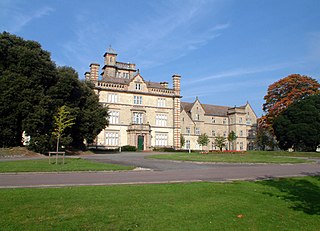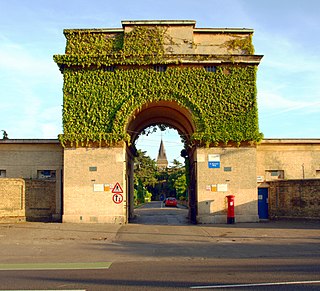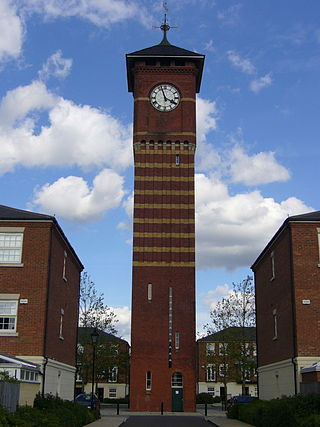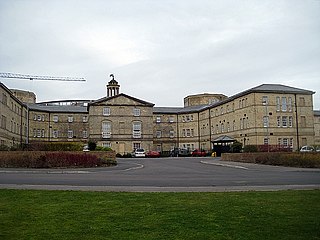
Barnwood is an suburb and former civil parish in the city of Gloucester, in the county of Gloucestershire, England. It lies about 1.8 miles (2.9 km) east of the centre of the city.

Fulbourn Hospital is a mental health facility located between the Cambridgeshire village of Fulbourn and the Cambridge city boundary at Cherry Hinton, about 5 miles (8 km) south-east of the city centre. It is managed by the Cambridgeshire and Peterborough NHS Foundation Trust. The Ida Darwin Hospital site is situated behind Fulbourn Hospital. It is run and managed by the same trust, with both hospitals sharing the same facilities and staff pool.

St Bernard's Hospital, also known as Hanwell Insane Asylum and the Hanwell Pauper and Lunatic Asylum, was an asylum built for the pauper insane, opening as the First Middlesex County Asylum in 1831. Some of the original buildings are now part of the headquarters for the West London Mental Health NHS Trust (WLMHT).

Robert Gardiner Hill MD was a British surgeon specialising in the treatment of lunacy. He is normally credited with being the first superintendent of a small asylum to develop a mode of treatment in which reliance on mechanical medical restraint and coercion could be dropped altogether. In practice he reached this situation in 1838.
Electroconvulsive therapy is a controversial psychiatric treatment in which seizures are induced with electricity. ECT was first used in the United Kingdom in 1939 and, although its use has been declining for several decades, it was still given to about 11,000 people a year in the early 2000s.
Psychosurgery is a surgical operation that destroys brain tissue in order to alleviate the symptoms of mental disorder. The lesions are usually, but not always, made in the frontal lobes. Tissue may be destroyed by cutting, burning, freezing, electric current or radiation. The first systematic attempt at psychosurgery is commonly attributed to the Swiss psychiatrist Gottlieb Burckhardt who operated on six patients in 1888. In 1889 Thomas Claye Shaw reported mental improvement in a case of General Paralysis of the Insane after a neurosurgical intervention. This led to a lively debate in the British Medical Journal on the usefulness of neurosurgery for the treatment of insanity. In the 1930s the Portuguese neurologist Egas Moniz developed a surgical technique for the treatment of mental illness and called it "leucotomy" or "psychosurgery". Moniz' technique was adapted and promoted by American neurologist Walter Freeman and his neurosurgeon colleague James W. Watts. They called their operation, where burr holes are drilled in the side of the skull and the white matter is sliced through in order to sever the connections between the frontal lobes and deeper structures in the brain, lobotomy. In the United Kingdom it became known as the standard Freeman-Watts prefrontal leucotomy. British psychiatrist William Sargant met Freeman on a visit to the United States and on his return to England encouraged doctors at the Burden Neurological Institute in Bristol to instigate a programme of psychosurgery.

Stone House Hospital was a hospital and former mental illness treatment facility in Stone, near Dartford, Kent, in the United Kingdom.

Warlingham Park Hospital was a psychiatric hospital in Warlingham, Surrey.

Kew Lunatic Asylum is a decommissioned psychiatric hospital located between Princess Street and Yarra Boulevard in Kew, a suburb of Melbourne, Australia. Operational from 1871 to 1988, Kew was one of the largest asylums ever built in Australia. Later known as Willsmere, the complex of buildings were constructed between 1864 and 1872 to the design of architects G.W. Vivian and Frederick Kawerau of the Victorian Public Works Office to house the growing number of "lunatics", "inebriates", and "idiots" in the Colony of Victoria.

Yarra Bend Asylum was the first permanent institution established in Victoria that was devoted to the treatment of the mentally ill. It opened in 1848 as a ward of the Asylum at Tarban Creek in New South Wales. It was not officially called Yarra Bend Asylum until July 1851 when the Port Phillip District separated from the Colony of New South Wales. Prior to the establishment of Yarra Bend, lunatic patients had been kept in the District's gaols. Yarra Bend was proclaimed an Asylum under the provisions of the Lunacy Statute 1867 (No.309) in the Government Gazette in October 1867.

Sunbury Lunatic Asylum was a 19th-century mental health facility known as a lunatic asylum, located in Sunbury, Victoria, Australia, first opened in October 1879.

Woodilee Hospital was a psychiatric institution situated in Lenzie, East Dunbartonshire, Scotland.

The Stanley Royd Hospital, earlier named the West Riding Pauper Lunatic Asylum, was a mental health facility in Wakefield, West Yorkshire. It was managed by the Wakefield and Pontefract Community Health NHS Trust.

The lunatic asylum, insane asylum or mental asylum was an early precursor of the modern psychiatric hospital.

Netherne Hospital, formerly The Surrey County Asylum at Netherne or Netherne Asylum was a psychiatric hospital in Hooley, Surrey in the United Kingdom.

Roundway Hospital was a psychiatric hospital in the parish of Roundway near Devizes, Wiltshire, England. It was originally called the Wiltshire County Lunatic Asylum and later the Wiltshire County Mental Hospital. It opened in 1851 and closed in 1995.

The Old Manor Hospital was a psychiatric hospital in Salisbury, Wiltshire, England. It was established in the early 19th century as a private licensed house called Fisherton House or Fisherton House Asylum, which became the largest private madhouse in the United Kingdom. In 1924, following a change of proprietors, it was renamed Old Manor Hospital and in 1955 it was amalgamated into the National Health Service. From 1813 to 1955 it was owned and managed by members of the same family. The Old Manor Hospital closed in 2003 and was replaced by Fountain Way, a smaller, modern, psychiatric hospital on part of the same site. In 2014 the site was acquired by Quantum Group for development as a residential estate and the conversion of the main building to a hotel.

Bellsdyke Hospital, also known as Stirling District Lunatic Asylum ('SDLA') or Stirling District Asylum, is a former psychiatric hospital at Larbert, Falkirk that was opened in June 1869 and largely closed in 1997. It was an asylum set up by the Stirling District Lunacy Board.

Coney Hill Hospital was a mental health facility in Gloucester, England.
Sir Frederick Needham was an English physician who was a Commissioner in Lunacy of the Board of Control for Lunacy and Mental Deficiency from 1892–1924.


















